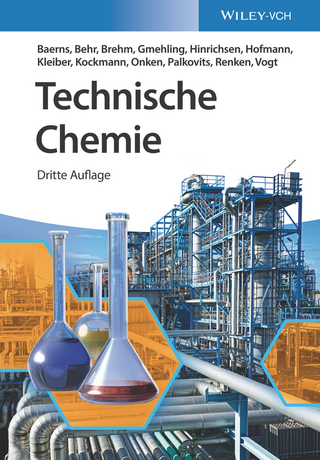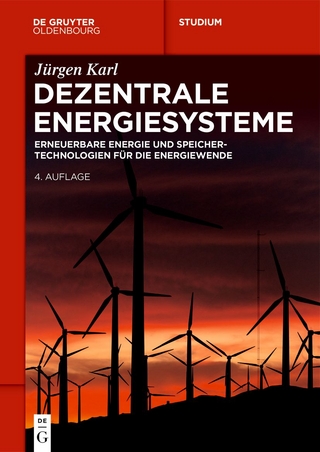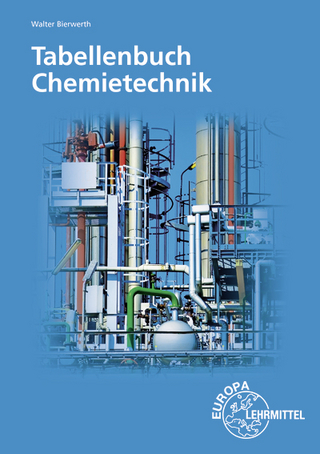
Fabrication and Application of Nanomaterials
McGraw-Hill Education (Verlag)
978-1-260-13223-6 (ISBN)
This practical chemical engineering textbook serves as an in-depth introduction to the synthesis, characterization, and functionalization of nanomaterials using solution-based methods. Written by a recognized expert in the field, the book combines theoretical fundamentals with experimental results. You will explore specific applications, including targeted drug delivery, hydrological tracing, water purification, and catalysis.
Fabrication and Application of Nanomaterials offers clear explanations and illustrates physio-chemical properties through state-of-the-art techniques, both in situ and post modifications. You will master the techniques for synthesis and applications of fabricated nanomaterials through concise theory, numerical problems, and recent case studies from industry and academia.
•This is the first graduate-level textbook to teach the fabrication of nanomaterials from a chemical engineering perspective•Presented in a multidisciplinary format that allows instructors to tailor a course for study•Written by a recognized expert and chemical engineering academic
Sulalit Bandyopadhyay earned a Ph.D. and M.Sc. in chemical engineering from the Norwegian University of Science and Technology (NTNU). He is a post-doctoral researcher in the Department of Chemical Engineering at NTNU and a visiting researcher at TU Delft and IHE Delft Institute for Water Education. He has been actively teaching chemical engineering courses at the graduate and post-graduate levels at NTNU since 2013. Dr. Bandyopadhyay's research interests include synthesis, characterization, and functionalization of nanoparticles; development of nanoparticle-based hydrological tracers; drug delivery; modeling of nanosystems; and recycling of Li-ion batteries.
About the Author
Contents
Preface
1 Introduction
1.1 Importance of Nanoscale
1.2 Inorganic Nanoparticles
1.2.1 Plasmonic Nanoparticles
1.2.2 Magnetic Nanoparticles
1.3 Organic Nanoparticles
1.4 Synthesis
1.4.1 Top-Down Synthesis
1.4.2 Bottom-Up Synthesis
1.5 Functionalization
1.6 Characterization
1.7 Applications
1.8 Study Questions
1.9 References
2 Nucleation
2.1 Classical Nucleation Theory
2.1.1 Activity-Based Supersaturation
2.1.2 Primary Nucleation
2.1.3 Nucleation Rate
2.1.4 Phase Stability and Phase Transitions
2.2 Alternative Nucleation Hypotheses
2.3 Concluding Remarks
2.4 Study Questions
2.4.1 Concept-Based Questions
2.4.2 Research-Based Questions
2.5 References
3 Crystal Growth
3.1 Classical Theory of Crystal Growth
3.2 Experimental Determination of Growth Rates
3.2.1 Seeded Batch Experiments
3.2.2 Seeded Constant Composition Experiments
3.3 Crystal Size and Size Distribution
3.4 Crystal Morphology
3.5 Concluding Remarks
3.6 Study Questions
3.6.1 Concept-Based Questions
3.6.2 Research-Based Questions
3.7 References
4 Synthesis of Metal Nanoparticles
4.1 Reduction of Metal Precursors in Solution
4.1.1 Mechanism
4.1.2 Parameters Influencing Nucleation and Growth
4.1.3 Examples of Metallic Precursor Reduction in Solution
4.2 Colloidal Templating: Reverse Micelles as Spherical Nanoreactors
4.3 Sol-Gel Method
4.4 One-Pot Synthesis Methods: Globular Proteins, Viruses, and Microorganisms
4.5 Nucleotide-Mediated Synthesis of Metal Nanoparticles
4.6 Natural Selection of Biomolecules Capable of Nanoparticle Formation
4.7 Seeded Growth of Gold Nanostructures
4.7.1 Under-Potential Deposition
4.7.2 Face-Specific Capping
4.7.3 Surfactant Templating
4.8 Study Questions
4.8.1 Concept-Based Questions
4.8.2 Research-Based Questions
4.9 References
5 Functionalization of Metal Nanoparticles
5.1 In Situ Functionalization
5.2 Post-Synthesis Functionalization
5.3 Langmuir Adsorption
5.3.1 Theoretical Basis
5.3.2 Assumptions, Caveats, and Validity
5.3.3 Macromolecular Adsorption
5.3.4 Protein Adsorption
5.3.5 Quartz Crystal Microbalance for Studying Adsorption
5.4 Study Questions
5.4.1 Concept-Based Questions
5.4.2 Research-Based Questions
5.5 References
6 Synthesis of Polymer-Based Nanoparticles
6.1 Classification of Polymer-Based Nanoparticles
6.1.1 Morphology
6.1.2 Hydrophilicity
6.1.3 Charge
6.1.4 Preparation Techniques
6.1.5 Phase-Based Classification
6.1.6 Mode/Type-Based Classification
6.1.7 Examples of Polymer-Based Nanoparticles: pNIPAm-Based Systems
6.2 Stimuli-Sensitive Hydrogels
6.3 Study Questions
6.3.1 Concept-Based Questions
6.3.2 Research-Based Questions
6.4 References
7 Functionalization and Properties of Hydrogels
7.1 Functionalization
7.1.1 In Situ Functionalization
7.1.2 Post-Synthesis Functionalization
7.2 Properties of Hydrogels
7.2.1 Size
7.2.2 Swelling Collapse
7.2.3 Optical Properties
7.2.4 Water Content
7.2.5 Mechanical Properties
7.3 Study Questions
7.3.1 Concept-Based Questions
7.3.2 Research-Based Question
7.4 References
8 Characterization of Metal Nanoparticles
8.1 Optical Properties
8.1.1 Scattering and Absorption
8.1.2 Localized Surface Plasmon Resonance
8.1.3 UV-Vis Spectroscopy
8.2 Dynamic Light Scattering
8.2.1 Theory
8.2.2 Autocorrelation Function
8.2.3 Stokes–Einstein Equation
8.3 Differential Scanning Calorimetry
8.3.1 Mathematical Background
8.3.2 Modulated Differential Scanning Calorimetry
8.4 Scanning Transmission Electron Microscopy
8.5 Fourier Transform Infrared Spectroscopy
8.6 X-ray Photoelectron Spectroscopy
8.7 Study Questions
8.7.1 Concept-Based Questions
8.7.2 Research-Based Questions
8.8 References
9 Applications in Catalysis
9.1 Introduction
9.1.1 Brief Introduction to Heterogeneous Catalysis
9.1.2 Adsorption
9.2 Nanoporous Materials—Catalyst Supports and Active Materials
9.2.1 Oxide Supports
9.2.2 Alumina and Silica
9.2.3 Zeolites and Zeotype Materials
9.3 Carbon Materials
9.4 Metal Particles
9.5 Summary and Further Reading
9.6 Study Questions
9.6.1 Concept-Based Questions
9.6.2 Research-Based Questions
9.7 References
10 Applications in Drug Delivery and Biomedicine
10.1 Drug Delivery
10.1.1 Passive Targeting
10.1.2 Active Targeting
10.1.3 Loading and Encapsulation
10.1.4 Drug Release and Mathematical Models
10.2 Magnetic Resonance Imaging
10.2.1 Fundamentals of Magnetic Resonance Imaging
10.2.2 Nanoparticle Contrast Agents for Magnetic Resonance Imaging
10.3 Biosensing
10.4 Study Questions
10.4.1 Concept-Based Questions
10.4.2 Research-Based Questions
10.5 References
11 Applications in Water Management
11.1 Wastewater Treatment
11.1.1 Adsorption
11.1.2 Membrane Separation
11.2 Hydrological Tracers in Water Management
11.2.1 Potential of Covered DNA Tracers: Case Studies
11.2.2 Colloidal Forces Governing Particle–Surface and Particle–Particle Contact
11.2.3 Colloid Filtration and Mechanistic Prediction of Retention
11.2.4 Continuum-Scale Transport Models
11.2.5 Transport of DNA Tracers in Surface Water
11.2.6 Challenges
11.3 Study Questions
11.3.1 Concept-Based Questions
11.3.2 Research-Based Questions
11.4 References
12 Applications in Energy Harvesting
12.1 Harvesting Energy from Heat
12.1.1 Overview
12.1.2 Nanomaterials for Heat Energy Harvesting
12.2 Photovoltaics
12.2.1 Overview
12.2.2 Nanomaterials for Photovoltaics
12.3 Mechanical Energy Harvesting
12.3.1 Overview
12.3.2 Nanomaterials for Mechanical Energy Harvesting
12.4 Magnetic Energy Harvesting
12.4.1 Overview
12.4.2 Magnetic Nanomaterials
12.5 Summary
12.6 Study Questions
12.7 References
Index
| Erscheinungsdatum | 11.06.2019 |
|---|---|
| Zusatzinfo | 200 Illustrations, unspecified |
| Verlagsort | OH |
| Sprache | englisch |
| Maße | 183 x 244 mm |
| Gewicht | 705 g |
| Themenwelt | Naturwissenschaften ► Chemie ► Technische Chemie |
| Technik ► Bauwesen | |
| Technik ► Maschinenbau | |
| ISBN-10 | 1-260-13223-4 / 1260132234 |
| ISBN-13 | 978-1-260-13223-6 / 9781260132236 |
| Zustand | Neuware |
| Haben Sie eine Frage zum Produkt? |
aus dem Bereich


